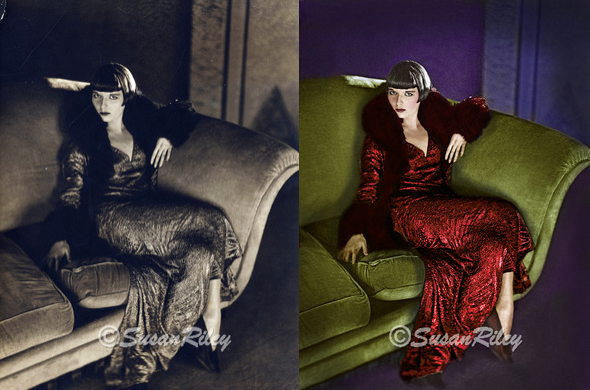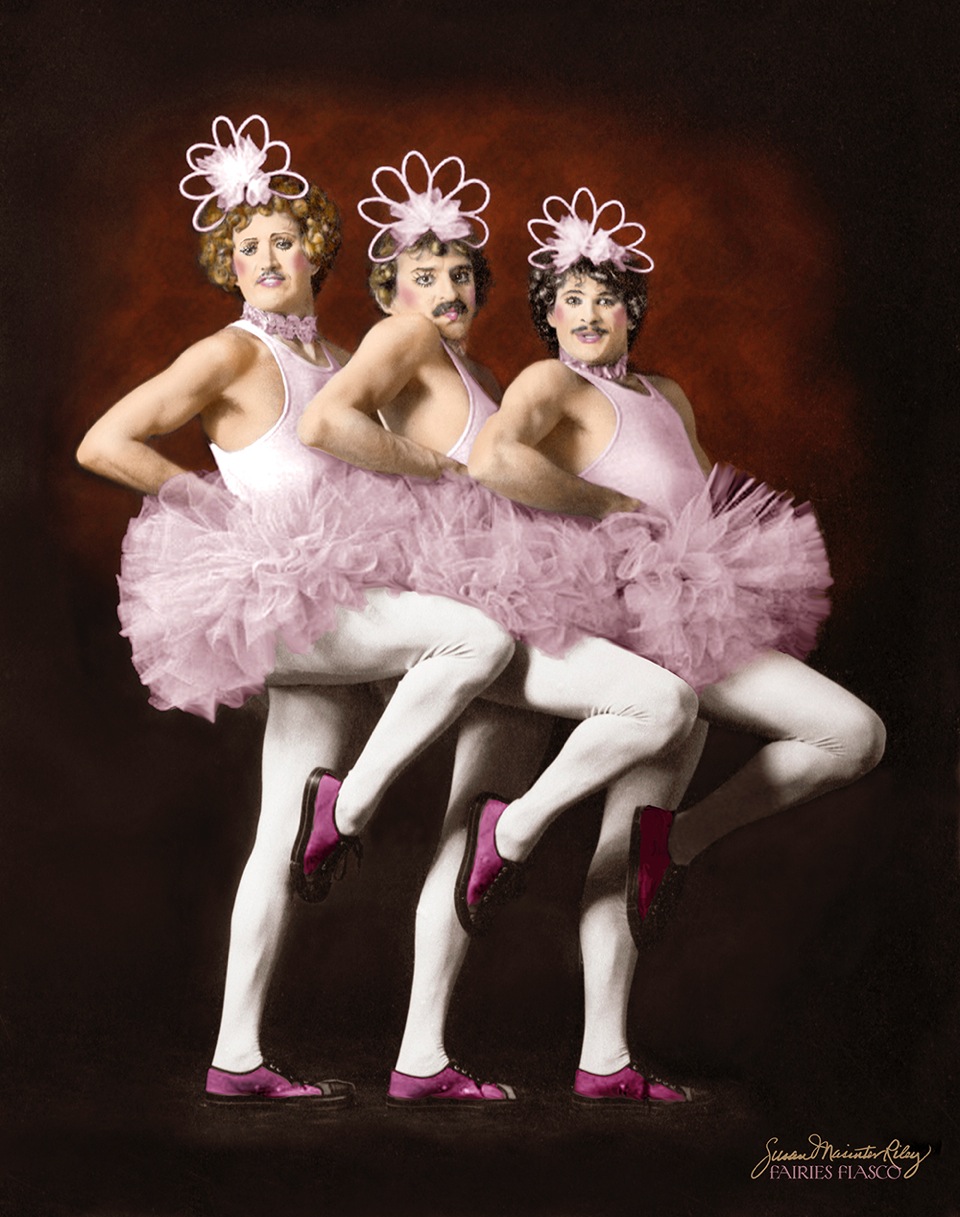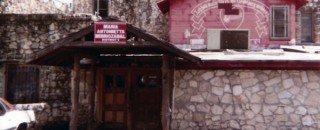“My shots of Elvis Presley from a concert here in San Antonio have been lost to the universe.”
Gene: Hi, Susan. Welcome to my humble Chartreuse Couch. I am so glad you could be here to talk about your photography for Fotoseptiembre. Just move those pillows over and sit and feel the love.
Susan: Hey, there, Gene. Thank you for having me! You know, you and I go all the way back to my humble beginnings in photography in the early ’70s. What should we talk about today?
Gene: Well, let’s just start with the recent and surprising collection of work you exhibited at the San Antonio Little Theatre. Amazing research!
Susan: Thanks! Remember, they switched the name to The Playhouse. The work was being shown there because they were presenting Funny Girl last summer and my current project deals with actors, entertainers, and dancers from the same period as Fanny Brice. It was a perfect fit.
To explain about the pieces: First I find a good black-and-white photograph online, usually of a gorgeous woman from the 1910s and 1920s. Sometimes the photo must be restored. All those years of “spotting” my own black-and-white prints by hand have really come in handy with the switch to digital production, especially cleaning up vintage photos. The next step is to research the woman in the photo, which entails hours of following leads online to find hair and eye color, and possibly what colors her dress and jewelry might have been. I cannot seem to stop there, though, and thoroughly enjoy reading about their lives and loves. In Photoshop, I color-enhance the image, often with little to go on but my imagination. For many years, I hand-colored my black-and-white custom prints using pastels and pencils, but when I went completely digital in the early 2000s, doing the color work at the computer and getting out of the darkroom held great appeal for me. Do you want to know about the next and totally scintillating step?
Gene: Yes, I do. The collection of actresses was most impressive and the restoration was really great.
Susan: Whee! This part makes me very happy! Looking back about 30 years or so, I was doing angel portraits of small children. I strapped on tiny feathered wings I made myself and plopped a tinsel halo on their little heads. This often led to screaming and crying, but once they calmed down, the photos were really dreamy. Microfine glitter was added directly to the halo on the prints I made, and once framed and lit, the effect was dazzling. Everyone loved it! The transition of this style to these vintage pieces has been thrilling for me. The jewelry worn in that time period, right before and during the Jazz Age, was scrumptious and complicated, from the diamond and pearl necklaces to the majestic headpieces worn to parties and dinners. Swarovski crystals, pearls, and teeny tiny specs of glitter give new life to these extravagant photos. It is wondrous to add gilded sparkle by hand-painting tiny areas. The work is slow and tedious, requiring lots of breaks and patience. The fun part is leaving the drawing table and taking the pieces to a spotlight to assess my work periodically. I am a child all over again! I never tire of looking at these beautiful women renewed with color in their cheeks, flowing, colorful gowns, and rich, glistening jewels. I have sold several and keep adding to my collection. Several clients have asked me to treat an old photo of a mother or grandmother with this technique, bringing tears of happiness. And currently I am working on a duchess from the Order of the Alamo court from last year’s Fiesta. Talk about time intensity and spectacularness.
Gene: They are really super. Okay, lets start at the beginning. You go back to the first years of the San Antonio Country and you documented my camp ballet, Fairies Fiasco. Tell us about how you got started.
Susan: I was working one summer, maybe 1972, at Mt. Washington Hotel in New Hampshire, and bought a used Argus C3 camera in a drugstore. No meter, bare bones, so I had to go with trial and error, learning about lighting and depth of field. That challenge and learning experience served me well over the years. I had left Trinity University after my junior year to “find” myself, realizing I would never become the concert pianist my parents wanted me to be.
In 1973, when someone mentioned the Southwest Craft Center, now the Southwest School of Art, was offering black-and-white darkroom classes, I thought, “What the heck!” and enrolled. Tom Wright, the instructor, changed my life forever, whether he knows it or not. The classes were fun and my classmates were brilliant. I think Kathy Vargas was in the darkroom with me at some point. Right away, I began coloring my prints, first with oil and then other mediums. I ran into you, Gene, at about this time as I used male models for figure studies. You were so gorgeous and bright and dare I say, even then, fearless. I made a few prints and experimented with toning but didn’t do much with the figure studies. Wisely, I have kept just about all my film over the years.
When you write your autobiography, we’ll have to include a few of those. Anyway, I continued to work in black-and-white for years, always setting up a darkroom in my home wherever I moved. You know, years later I was asked to present a workshop on toning at the Craft Center over a weekend. I got a kick out of being back on the campus in the role of teacher.
Gene: Let’s talk about the bigger picture. September is the month that Michael Mehl developed for us to really look at photographs. What do you like in other photographers and their work?
Susan: When I shot with film, I used to run into Michael at Alamo Photolab on Broadway. He has done a remarkable job of bringing photography in San Antonio on par with other fine art. I’m going off on a tangent here: The term “photograph” implies something made within the camera, a moment captured in time. Most of what we see today has been heavily manipulated in post-production, my work included. I would venture to guess that just about every photographer today is doing something to his or her work after shooting. As a matter of fact, I have had an ongoing argument with another photog about film and darkroom vs. digital and manipulation. He says I am basically lying when I present one of my pieces as a “photograph” because I have enhanced it beyond what my eye saw when I took the photo. Are you kidding? He spends hours in the darkroom, as I once did, dodging shadows, burning light areas, finding or concealing details his eye saw but the camera cannot differentiate. All those details are stored in that image if you just know how to coax them out. Even the vintage portraits I find online have so much going on in those shadows, it thrills me to reawaken what the photographer saw so long ago.
Thinking about your question regarding other photographers, I feel if the finished piece is done well and draws my eye and interest, it is a success. My friend the late Herman Leonard made exquisite portraits of jazz greats during the ’40s and ’50s. His fabulous black-and-white prints, now selling for big bucks, will stand the test of time. San Antonio is loaded with talented people using cameras! I hope everyone gets to discuss the work with the photographers during September at one of the many galleries featuring this medium.
Gene: Well, that brings us to Finding Vivian Maier. Have you seen this super documentary?
Susan: No, Gene. I have only read a little about her. I wonder if long after I’m gone someone will find value in all the thousands of negatives and digital files I have shot.
Gene: Well, I know which ones I want, of course, the ones of Fairies Fiasco. I do hope those are still safe. Have you ever seen a UFO?
Susan: Ha! What a funny segue! First, I have lost few negatives over the years and some are precious to me, among them my Rolling Stones 1976 concert photos and my studio photos of the performers in Fairies Fiasco. Sad to say, my shots of Elvis Presley from a concert here in San Antonio have been lost to the universe. My fault for being careless with the film-processing.
As for UFOs, I do have an account of a strange event from the early ’70s. Some friends had gathered outside someone’s home, just north of San Antonio. At that time, just north of the city was still pretty much countryside. I recall my boyfriend and I were about to leave, saying our goodbyes when a bright flash of light made us all whirl around and look to the skies. There was no thunder, no wind, no rain. A typical hot-as-hell summer night in South Texas. We looked at each other in shock, not knowing what to make of it. The entire area had been lit up, much like lightning illuminates miles around. As we stood waiting for what else might come, we nervously began to laugh and wondered if we had just imagined it. The next day we searched the newspaper for articles explaining this phenomenon. There was nothing. Someone suggested maybe the U.S. Army had been doing some kind of testing … We never did know what it was and I have never experienced that again. I know this subject is something that interests you and I wish I had more to report. To my knowledge none of us were pulled up into a spaceship for experiments. Now if I had had my camera at the ready, maybe I could have recorded our ashen, perplexed faces. Did I mention we were slightly intoxicated or some such thing?
Gene: Interesting. Well, moving right along. What do you think about the fuss over Alamo Plaza and closing Alamo Street, making it harder and harder and more aggravating to get through downtown than it already is? I don’t know anyone who likes that idea. How about you?
Susan: Hmmmm. You have segued again. I don’t agree with you on this issue about Alamo Plaza, Gene. By the way, I took a really cool photo of you in front of the Alamo a good many years ago.
Back to your question: It seems the City is going to take a long, hard look at how to proceed with the project but I have a feeling it will happen sooner or later. Yes, it is problematic that it sits smack dab in the middle of downtown and much of the original footprint lies beneath other buildings. I won’t be sorry to see certain businesses relocated that now sit, in all their garish glory, directly across from the old mission. I go out of my way to drive past the Alamo all the time and always turn to take a look, but it is hard to ignore the circus on the other side of the street. No names mentioned. There is never a lot of vehicular traffic in front of the Alamo, Gene. With the construction going on right now at the old Joske’s building and the street narrowed to one lane there, people are already finding others ways to get around. Aggravating a few drivers should not block the restoring of the Alamo grounds. To me, it is a very worthy project. We can debate this sometime over breakfast!
Gene: You pick a topic about our fair city. What is of concern to you: art, politics, health, aquifer, cooking, anything?
Susan: I do have something to say about San Antonio. Coming from New Orleans, it is not that simple to find a city with as much charm, diverse culture, range of musical/artistic tastes and interesting things to do as the Crescent City offers. Landing in San Antonio to attend Trinity University, I never thought I would keep returning to this town after sampling various parts of the country. Sure, there are problems here as in any large city and there are plenty of things to complain about, but we seem to be heading in the right direction for the most part. I am impressed with some of the initiatives the City is setting forth for preschool and children’s welfare. It is grand to see the Tobin Center completed and offering such variety. Luminaria is just one of the cool events open to the entire city. Maybe they’ll put my sparkly ladies up this year! This town has a whole lot going for it. My, this is a pretty couch … is it velvet?
Gene: It is a really expensive imported material from Mars that was made especially for me. And you can sign your name along with the others. Okay, where are you favorite places to eat in San Antonio?
Susan: You know, I am sort of wishing for a piece of the extraordinary cheesecake Hap used to have in the Kangaroo Court. Remember that? We were all full of ourselves back then. I still enjoy going to the River Walk for dining now and then but so much has changed. I like to keep it simple and stay close to home. I have always liked Cappy’s. And the veggie burger at J. Alexander’s is hard to beat. The chiles en nogada is a wonderful dish at the Picante Grill.
Way, way off subject, one of my favorite things is going into Brackenridge Park behind the museum and photographing the egrets as they nest in the big trees adjacent to the zoo. I don’t know what to do with these pretty photos but I can’t stop making them. I’ll send you one.
Gene: Tell me about one of the colored photos that you brought. Who is this?
Susan: This is Louise Brooks as photographed by James Abbe, 1930. Louise appeared in the film Prix de Beauté and wore this dress. When I saw the original black-and-white and the “I dare you” look on her face, I was drawn to give her color. The research on Louise was fascinating and led me to two more pieces with her as the subject. I can never tell what color things might have been but “the look” made me select red for her gown. The ensemble has a matching jacket trimmed in fur and she is seated on a velvet sofa which I colored, of all things, chartreuse! Everything about this piece is stunning. The dress, embellished with teeny tiny minuscule shades of red microfine glitter give off a glow that invites you to lean in as close as possible to inspect the handwork. That took forever! I am really pleased how the fur trim came out.
I continued reading about Louise and found an article online about the dress! Can you believe it? She bought it in Paris at the House of Patou and actually wore it in more than one film. And then, I read the line that made me gasp: The dress was not red at all but bronze. What? Louise Brooks would not wear bronze! It is clear to me this dress was only available in the one color. Look closely, Gene. See the glimmer in her eye? It’s because she is in red! And by the way, she was bisexual.
Gene: And now you get to ask me the final question. I always let my guest ask the last question.
Susan: Easy. The obvious question would be, how excited are you about the Supreme Court ruling on gay marriage? Were you surprised at this? Is marriage for you?
Gene: I’m still single and I plan on keeping it that way. The gay community has always been a surprise for me. A surprise party.
Susan: Well, then, I want to ask something else. I still cherish a couple of handmade paper pieces you made years ago. Are you still making art?
Gene: Sometimes. I like to interview artists more. Thanks for coming to the Chartreuse.
Susan: Thanks for having me on your couch.





